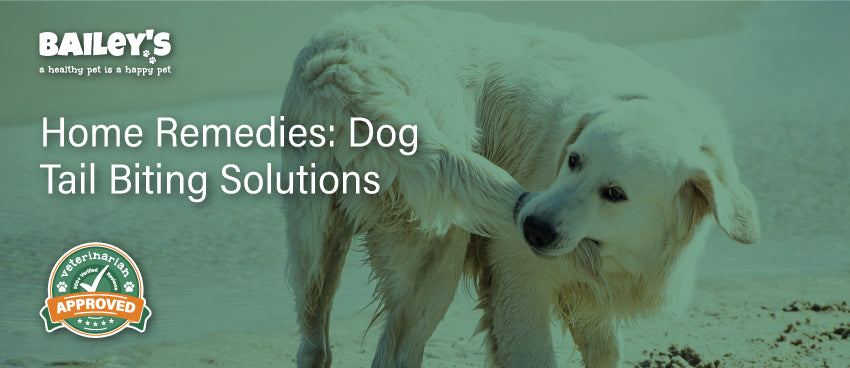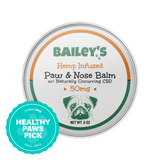Home Remedies: Dog Tail Biting Solutions

Dog tail biting is a common issue that many pet owners face. Not only can it be frustrating, but it can also cause discomfort and even injury to your furry friend. Understanding the causes of tail biting and learning how to prevent and treat it can help you find a resolution for this behavior. With the help of the friendly folks at Bailey’s CBD , we will explore various home remedies and training techniques to address dog tail biting.

Table of Contents
1. Understanding the Causes of Dog Tail Biting
Dog tail biting is a common behavior that can be caused by a variety of factors. It is important to understand the underlying reasons behind this behavior to effectively address and manage it.
1.1 Psychological Factors Leading to Tail Biting
One of the main reasons why dogs engage in tail biting is due to psychological factors. Boredom, for instance, can lead to restlessness and a need for stimulation. When dogs do not have enough mental or physical exercise, they may resort to tail biting as a way to release pent-up energy.
Anxiety and fear are also significant contributors to tail biting. Dogs that experience high levels of stress may develop this behavior as a coping mechanism. Tail biting provides them with temporary relief from their anxiety, although it is not a healthy or productive way to deal with their emotions.
Furthermore, frustration can play a role in tail biting. When dogs are unable to achieve their desired goals or when their needs are not being met, they may resort to this behavior as a way to express their dissatisfaction.
Identifying and addressing these underlying psychological factors is crucial in effectively managing tail biting. Providing dogs with plenty of mental and physical stimulation, as well as creating a calm and secure environment, can help alleviate their stress and reduce the likelihood of tail biting.
1.2 Physical Conditions Promoting Tail Biting
In addition to psychological factors, it is important to rule out any physical conditions that may be causing your dog to bite its tail excessively. Skin allergies, for example, can cause itching and discomfort, leading dogs to chew or bite at their tails in an attempt to alleviate the irritation.
Infections, such as bacterial or fungal infections, can also contribute to tail biting. These infections can cause inflammation and discomfort, prompting dogs to engage in this behavior as a way to find relief.
Parasites, such as fleas or ticks, can be another culprit behind tail biting. These pesky creatures can cause intense itching and irritation, driving dogs to bite or chew at their tails to get rid of the pests.
Regular veterinary check-ups are highly recommended to rule out any underlying medical causes of tail biting. Your veterinarian can conduct a thorough examination and perform tests if necessary to identify and treat any physical conditions that may be contributing to your dog's tail-biting behavior.
2. Identifying Symptoms of Tail Biting in Dogs
Tail biting in dogs can be a distressing behavior that may indicate underlying issues. Dog owners need to be able to identify the symptoms of tail biting to address the problem promptly. In this article, we will explore the visible signs of tail biting as well as the behavioral changes that may indicate this behavior in dogs.
2.1 Visible Signs of Tail Biting
One of the first signs of tail biting is the appearance of hair loss or redness at the base of the tail. This can be a result of the dog biting or chewing on the area excessively. In some cases, small wounds or open sores may also be present, indicating that the dog has been biting its tail aggressively. It is important to note that tail biting can cause discomfort and pain for the dog, leading to further complications.
Another visible sign of tail biting is excessive licking or chewing on the tail area. Dogs may engage in this behavior as a way to alleviate itching or irritation caused by the biting. If you notice your dog constantly licking or chewing on its tail, it is important to investigate further to determine if tail biting is the cause.
In severe cases, tail biting can lead to bleeding or signs of infection. If you see blood or notice any signs of infection, such as pus or foul odor, it is crucial to consult your veterinarian immediately. They will be able to provide appropriate treatment and address any underlying issues that may be contributing to the tail-biting behavior.
2.2 Behavioral Changes Indicating Tail Biting
Aside from the visible signs, dogs that engage in tail biting may exhibit behavioral changes. These changes can be an indication of the dog's distress and discomfort caused by the tail-biting behavior.
Restlessness is a common behavioral change observed in dogs that engage in tail biting. The constant discomfort and pain can make it difficult for the dog to settle down and find a comfortable position. They may pace around, unable to find relief from the irritation caused by the biting.
Irritability is another behavioral change that may be seen in dogs with tail biting. The constant discomfort can make the dog more irritable and sensitive to touch or interaction. They may snap or growl when approached or when their tail is touched, as it exacerbates their pain and discomfort.
Dogs that engage in tail biting may also have difficulty sitting or lying down comfortably. The pain and inflammation caused by the biting can make it uncomfortable for the dog to rest in certain positions. They may constantly shift positions or have difficulty finding a comfortable spot to relax.
Furthermore, tail biting can lead to increased anxiety and aggression in dogs. The constant discomfort can cause the dog to become more anxious and on edge. They may display signs of distress when the tail is touched or approached, such as growling, snapping, or even biting. It is important to approach a dog with tail-biting behavior cautiously and with care to avoid further distress.
By paying attention to these behavioral changes, dog owners can identify tail biting early on and seek appropriate help. Consulting with a veterinarian or a professional dog behaviorist can provide valuable guidance in addressing the underlying causes of tail biting and finding effective solutions to manage the behavior.
3. Home Remedies to Prevent Tail Biting
Tail biting in dogs can be a frustrating behavior to deal with. Not only can it cause discomfort and irritation for your furry friend, but it can also lead to further complications such as infections or injuries. While it's always important to consult your veterinarian for proper diagnosis and treatment, there are some natural remedies you can try at home to help prevent tail biting.
3.1 Natural Oils and Their Benefits
One effective way to soothe your dog's irritated tail and reduce the urge to bite is by using natural oils. These oils have calming properties that can alleviate itching and promote healing. Coconut oil, for example, is known for its moisturizing and anti-inflammatory properties. Lavender oil, on the other hand, has a soothing scent that can help relax your dog and reduce stress. Chamomile oil is also beneficial, as it has anti-itch properties and can help relieve any discomfort your dog may be experiencing.
To use these oils, it's important to dilute them in carrier oils like olive oil or coconut oil. This helps to ensure that the oils are not too concentrated and won't irritate your dog's skin. Once diluted, gently apply the mixture to the affected area, massaging it in to promote absorption. However, it's crucial to consult your veterinarian before using any oils or supplements on your dog, as some dogs may have allergies or sensitivities to certain oils.
3.2 Homemade Sprays to Deter Biting
If your dog's tail-biting behavior persists, you may want to consider creating homemade sprays to deter them from chewing on their tail. One popular option is a mixture of apple cider vinegar and water. The bitter taste of apple cider vinegar can discourage your dog from biting due to its unpleasant flavor. Simply mix equal parts of apple cider vinegar and water in a spray bottle, then spray it onto your dog's tail. However, it's important to note that apple cider vinegar may cause a stinging sensation if your dog has any open wounds or sores, so it's best to avoid using it in such cases.
Another option for a homemade spray is diluted lemon juice. Lemon juice has a sour taste that dogs generally dislike, making it an effective deterrent. Mix lemon juice with water in a spray bottle, then apply it to your dog's tail. Alternatively, you can use peppermint oil, which has a strong scent that dogs find unpleasant. Dilute a few drops of peppermint oil in water, then spray it onto your dog's tail. However, it's important to test the spray on a small area first to ensure that your dog doesn't have any adverse reactions to the ingredients.
Remember, while these home remedies can help manage tail-biting behavior, it's essential to address the underlying cause. Tail biting can be a sign of various issues, including allergies, skin infections, anxiety, or boredom. If your dog continues to bite their tail despite trying these remedies, it's crucial to seek professional advice from your veterinarian to determine the root cause and develop an appropriate treatment plan.

4. Training Techniques to Stop Tail Biting
4.1 Positive Reinforcement Strategies
Positive reinforcement training focuses on rewarding desirable behaviors rather than punishing unwanted ones. When your dog refrains from biting its tail, reward it with treats, praise, or playtime. This technique helps redirect your dog's attention and encourages alternative behaviors, reinforcing the idea that tailbiting is not rewarding.
4.2 Distraction and Diversion Methods
Another effective training technique involves distracting and diverting your dog's attention away from its tail. Offering engaging toys, puzzle games, or going for walks can shift its focus to more positive activities. Keep your dog mentally and physically stimulated to discourage tail biting and channel its energy elsewhere.
5. When to Seek Professional Help
5.1 Recognizing Severe Tail Biting Cases
In some cases, tail biting may persist or worsen despite your best efforts. If your dog's tail biting becomes severe, with excessive bleeding, infection, or extensive damage to the tail, seek veterinary assistance immediately. A professional can assess the situation, provide appropriate medical treatment, and offer further guidance on managing the behavior.
5.2 Choosing the Right Veterinarian or Dog Behaviorist
Finding the right veterinary professional or dog behaviorist is crucial when seeking help for tail biting. Look for professionals experienced in canine behavior and tail biting specifically. They can conduct a thorough evaluation, recommend tailored treatment plans, and provide valuable insight into addressing the underlying causes of tail biting. Don't hesitate to ask for referrals and check reviews before making a decision.











